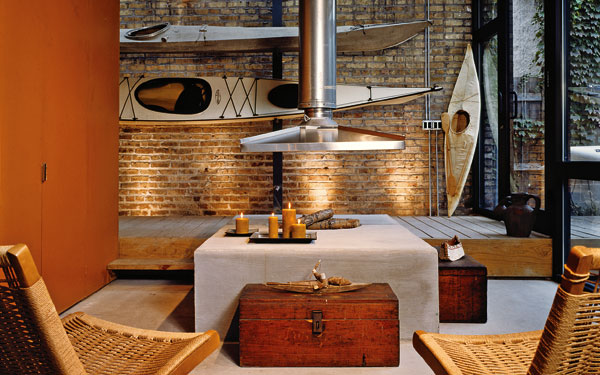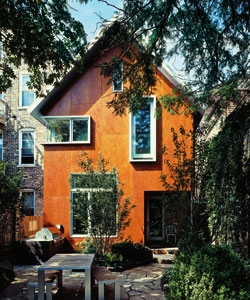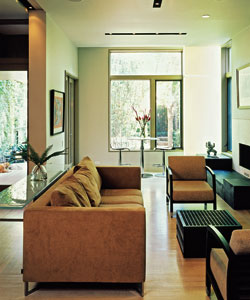
A fire pit makes the boathouse a cozy spot to hang out in the winter. Photo Gallery::: |
Stroll past Tim Goodsell’s East Village home, and you’d likely assume it’s another charmingly rehabbed English brick cottage, typical of those that have dotted the neighborhood since the late 19th century. But inside is a series of modern rooms that telescopically become larger and more open, culminating in a sleek, airy family room overlooking an enormous back garden. "Our intent was to make a kind of secret addition that didn’t affect the street presence," explains architect Paul Florian.
The enlargement of the cottage was necessary to accommodate Goodsell’s partner, Susan McGee. Goodsell had the kitchen remodeled with a contemporary aesthetic several years ago, and that became the springboard for the design of the addition, which included the family room and, above it, a master suite.

"The idea of the whole back piece of the house was a kind of riff on a contemporary version of a bungalow," says architect Paul Florian. Photo Gallery::: |
The expansiveness of the design hinged on another aspect of the cottage not apparent from the street: An early incarnation of the el once ran along what is now the alley behind it. After the line was abandoned, homeowners were allowed to purchase part of the alley, making the lots extra deep. Goodsell’s property is even larger than most, as he owns the four-flat and the six-flat that flank the cottage to the north and south, respectively. He bought the three properties a decade or so ago, when he was a tenant of the previous owner, who relocated and offered them to him.
How does one go about giving a historically rooted home a modern edge without creating a mess of contradictions? "By creating the illusion of the vernacular form on the outside, then trying to erode it with contemporary components," Florian says. Thus the roof, for instance, is steeply pitched, as expected. But instead of covering it with shingles and hanging gutters from the bottom, Florian and his team designed a surface made of industrial-looking aluminum; the gutters are integrated into the structure and are not visible from the ground. "We wanted a very crisp form," Florian says, "and not distinguishing between the edge of the roof and the top is one way of making that statement."
Another way was by using a rainscreen of weatherproof wood veneer panels to clad the sides and rear of the house. While lending a warmth and richness many contemporary designs lack, the cladding also creates a clean, sleek surface. "It makes the building look like a big cabinet, and that’s another thing that interested us," Florian says. "Is it a tiny building, or is it a big one? It has a funny ambivalence that I like." Echoing the roof, bold aluminum trim outlines the exterior of the master suite’s corner window and "balcony" door with glass panel- another nontraditional detail-providing balance to the overall composition.
For the family room, the couple wanted "a lot of light and openness," McGee says, to help erase the barrier between the house and the lush plantings that would be installed after construction was completed. Where a traditional cottage would simply have a window overlooking the garden, Florian instead paired a large three-paned window with a translucent acrylic light box that boosts the illumination. The box sits astride one of the most unusual elements of the home, a concrete hearth/window seat that bursts through the back wall, extending several feet into the garden to hold an outdoor grill. The juxtaposition of interior and exterior also is evident in the cozy deck just outside the kitchen door, where, unexpectedly, there’s a ceiling that’s the same height as the entryway next to it.

Where a traditional cottage would typically have a window in the back right corner of the family room, Florian instead installed an enormous light box. Photo Gallery::: |
All the construction decimated the somewhat overgrown garden, presenting landscape architect Cosmo Ferraro with the challenge of installing a new garden that didn’t feel new. "Tim and Susan wanted to add a northern Wisconsin feeling," he explains. "Tim was adamant that there not be a lot of small plant material that he’d have to wait to grow in." In the main garden, Ferraro installed mature evergreens and shade-tolerant, low maintenance shrubs and groundcover.
Steps cut from a single boulder that Ferraro selected himself at a granite quarry lead back, secret-garden style, to a sunny deck with a fire pit and raised beds of flowering perennials. The overall effect of these outdoor rooms, Ferraro says, is that "you can sit back there and almost feel like you’re not in the city."
Just a few steps out the back door is what used to be a stable, complete with stalls and hayloft, for horses that were involved in the old transport system. The building was gutted to create a boathouse for Goodsell, a passionate kayaker. With concrete floors, a bathroom with a shower, and room for several kayaks, it’s a highly functional space. But it also was designed to be a sort of clubhouse, where Goodsell and friends could strip off their gear and have a drink from the mini fridge after a day on the lake.
A concrete square provides extra seating alongside the fire pit built into the center of the space and a wooden "pier," which acts as a gangway for unloading the kayaks that hang above. It runs through a glass-walled doorway, extending all the way to the back edge of the property, where boats are unloaded. "Again, it erodes the division between interior and exterior," Florian points out. "You’re thinking about being in a bunch of rushes instead of an alley."
Hung above the pier is a kayak that looks more like folk art than sporting vessel. Goodsell spotted the hunting craft, made from recycled scraps of wood, while waiting for transport on an island in Greenland; he traded it from the maker for his skis and a pair of binoculars.
Goodsell and McGee love the compound that Florian and his team created for them, though Goodsell ruefully notes that the project ended up costing roughly double what he had originally budgeted. He has no regrets, however. "Paul is very creative," McGee says. "When he tells you these great ideas, you get excited and want to do them."
For information on resources, see Buyer’s Guide.
Photography: Kate Roth
Styling: Arden Nelson
Related:



